Introduction
A new beauty industry era is rising. Young consumers are leaning toward cosmetic brands that promote inclusivity and diversity. They want representation as the definition of beauty evolves. Beauty brands are also shaping trends, shifting towards authenticity and transparency.
We see hundreds of up-and-coming cosmetic makeup brands offering innovative and eye-catching niche beauty products. Hence, there's a need for brands to have a strategic and adaptable approach.
If you’re wondering how to prime your beauty brand for success, you’re in the right place. Read on as we tackle the in and out of beauty branding and how to navigate it.
Defining Beauty Branding
What is beauty branding?
Beauty branding, or cosmetic branding, refers to the comprehensive process of establishing an identity unique to your company. These include your brand logo, choice of colors, typography, textures, images, etc.
But beyond aesthetic elements, brand identity assets are anchored on your brand mission, vision, and message, making you stand out from the competition.
With a reputable and recognizable cosmetics brand, your chance of increasing the buying decision of your target audience increases. Think L’Oreal and Revlon, two powerful brands with over 100 years of presence in the global market.
So, what’s their secret to having a successful beauty brand? Brand consistency.
The Importance of Consistency in Beauty Branding
The beauty market has produced over 4,000 brands worldwide, with a forecasted revenue of $129 billion by 2028. As an emerging brand, it’s tricky to get to the top or be noticed.
This is where being consistent across your makeup branding strategies becomes handy. While product design changes occur according to trends and seasons, retaining your logo and color palette reinforces your brand’s presence.
To maintain this level of visual cohesion, many emerging beauty founders collaborate with a branding design agency that can translate their core values into assets built to evolve without losing recognizability.
Aside from maintaining an identifiable appearance, consistency helps establish an emotional connection with your target audience. You can do this by picking endorsers or influencers who can grow with your brand in the long run.
In effect, your makeup branding identity can strengthen your brand value over time. Of course, consistency doesn’t mean ignoring change. There is also value in carefully and strategically evolving as a brand to adapt to the changing demands and needs of your target market.
Steps for Creating a Beauty Branding Identity
Competing in the makeup branding industry takes work. But with a strong foundation, you can launch your brand for success. We break down the process of creating a beauty branding identity as demonstrated by MAC Cosmetics.
Step 1: Define Your Brand
When you identify what is unique to your brand, you are more likely to satisfy the needs of your market. Finding your positioning in the industry and defining your brand message keeps your brand goals on track, too.
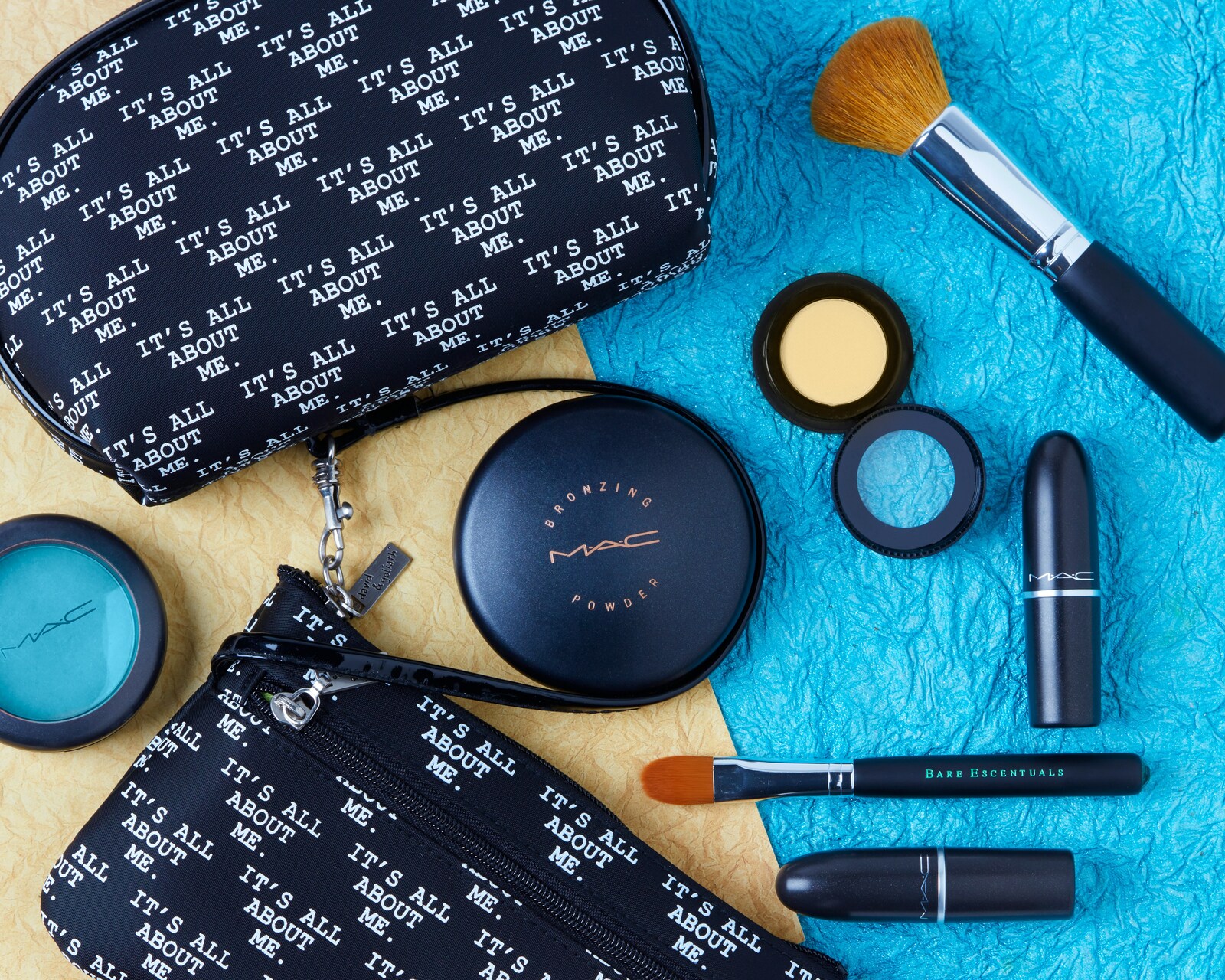
MAC Cosmetics is a brand that stands for creative self-expression through makeup. Image via Unsplash
MAC stands for Makeup Art Cosmetics, a company made originally for professional makeup artists. Due to the demand from non-professionals, MAC decided to expand its market and sell directly to individuals.
By defining its brand, it has remained steadfast in committing to its mission of “enabling limitless self-expression by turning makeup into art for ALL – you included.”
Step 2: Identify Your Target Audience
Knowing your audience gives insight into your demographic’s interests, buying behavior, and other concerns so you can invest in campaigns that resonate with them. Understanding your audience also helps tailor the perfect products that address their pain points. Ultimately, this leads to increased brand satisfaction and brand loyalty.
While MAC caters to diverse customers around the globe, it mainly targets younger audiences, predominantly young women, who are into trendy, fashion-forward, vibrant, and high-quality cosmetics. MAC works with young celebrities and influencers like Saweetie, Lisa from BLACKPINK, TikTok star Sabrina Bahsoon, and Danna Paola as part of its makeup branding strategy.
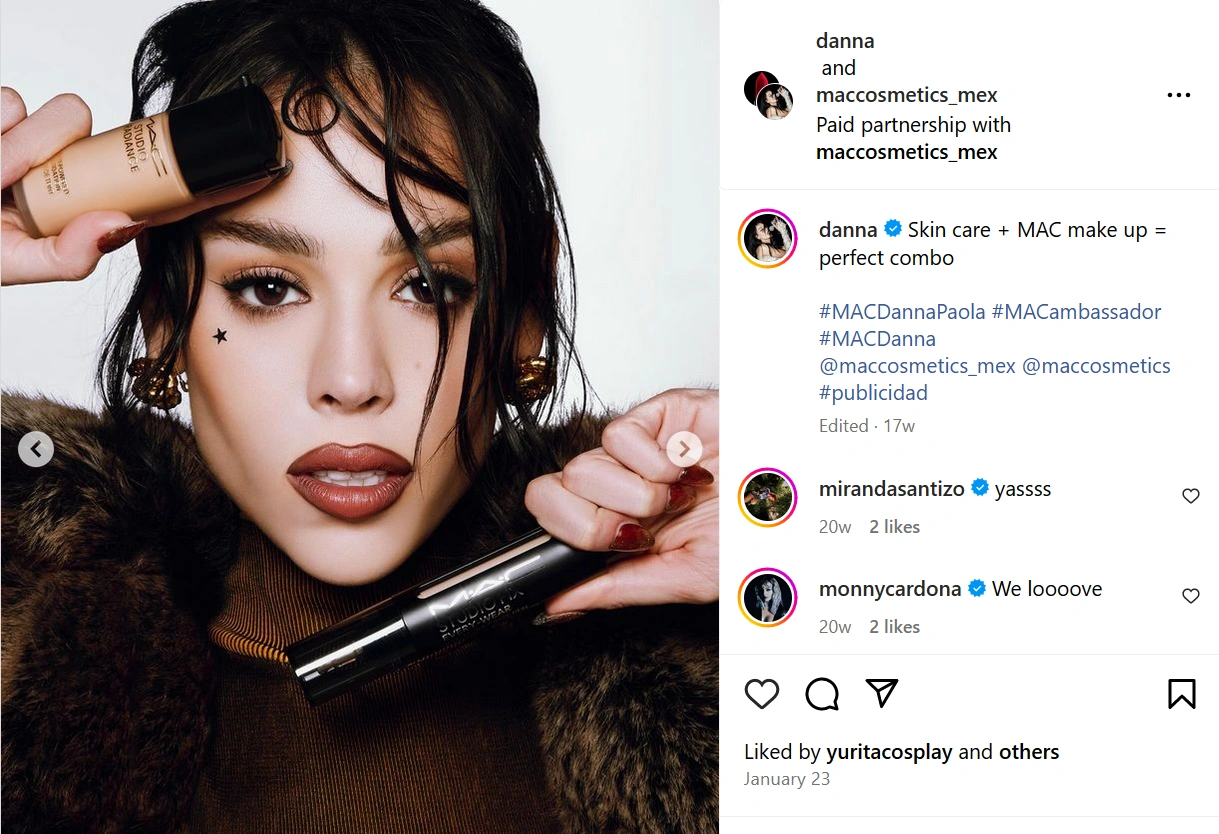
Partner with influencers your audience resonates with. Image via Instagram
Step 3: Develop a Unique Brand Voice
You wouldn't want your customers to feel like they're talking to a soulless corporate entity. For your makeup branding to take human form, you need a brand voice.
Brand voice is essential to establishing a beauty brand. It enables you to connect with your customers easily and gain their trust. With a recognizable brand voice, customers are more receptive to what you offer to address their pain points.
So, what does your brand voice sound like? Are you authoritative, conservative, playful, or motivational?
For MAC Cosmetics, the brand has a confident and empowering voice that encourages self-expression. As a result, customers who love pushing boundaries and celebrating diversity in beauty gravitate towards the brand.
Step 4: Design a Memorable Logo and Packaging
One way for your makeup branding identity to make an impact at a glance is through a memorable logo and product packaging. It pays to have a logo and packaging design that communicates the quality of your products and the brand's core values.
MAC has created a timeless and minimalistic logo. The bold black font indicates the brand’s commitment to challenging the norms. As a whole, the logo is a symbol of innovation and resilience, transcending generations.
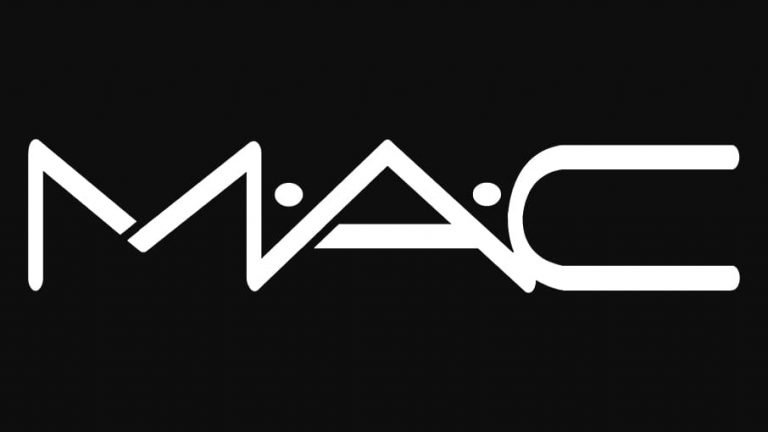
A good cosmetics brand logo is memorable, timeless, and unique. Image via 1000 Logos
The brand has also created a distinct packaging design, like its black bullet lipsticks. The products come in a black box and tube with the logo embossed in white.
The makeup branding design may be simple, but the stark contrast between the colors and the iconic logo makes it effective in capturing the attention of potential customers.
Effective Marketing Strategies for Beauty Brands
How you build a beauty brand depends on several factors, like business goals and customer needs. Here are effective marketing strategies to help you stay ahead of the curve.
Social Media Marketing
While it may be tempting to be present everywhere, choose social media platforms that cater to your audience. For instance, Instagram and TikTok are great for customers who value highly visual and aesthetically pleasing content.
Participate in trends, use relevant hashtags, and leverage insights to push for engagement, increase visibility, and improve brand performance on social media. You can also monitor and join conversations to know what interests your audience, which is helpful in product development and makeup branding campaigns.
With a strategic social media presence, you can harness it to grow your community and brand sales.
Collaboration and Influencer Marketing
With younger demographics yearning for authentic connection with brands, they are more likely to listen to non-celebrities who represent them and their struggles.
So, consider partnering with influencers who align with your brand values and have a significant following. They can share real-life experiences and opinions about your brand that resonate with your audience. This makeup branding strategy strengthens the bond with your customers, enhancing trust.
Consider cross-promoting with other brands adjacent to yours, too! For instance, you can partner with clothing brands and collaborate on an event, like a fashion show. With an innovative partnership, you can appeal to untapped audiences and open creative opportunities to showcase your brand.
Content Marketing and Storytelling
Engaging and relevant content is vital to the success of your SEO (search engine optimization) efforts. Keywords, phrases, and brand names, strategically used, can increase website traffic and visibility on search engine results.
With your audience hooked, they are more likely to leave a comment, share, and create content using your products. Suffice it to say, that content marketing is pivotal to amplifying brand awareness and recognition.
In addition, integrating storytelling in your content allows for an emotional connection with your audience. You can tailor storytelling strategies to communicate your brand essence effectively.
Case Studies: Top Beauty Brands
Now, we explore the world of successful beauty brands and discover what makes them stand out.
Glossier: Creating a Beauty Empire
Young cosmetic brand Glossier has taken the stage on Instagram with its pastel-themed and minimalist images. The brand radiates a classy and feminine look, inviting attention from young customers. Through Glossier’s approachable vibe, it created a community of beauty enthusiasts willing to have a conversation with the brand.
1. Nurturing a Community of Beauty Enthusiasts
While Glossier aims to sell products, it wants to foster and educate its community, too.
As part of its makeup branding strategy, Glossier shared blogs, product reviews, and tutorials accessible to everyone. With an empowered and engaged community, followers of the brand were soon posting content with the branded hashtag #glossierpink, which it leveraged in marketing.
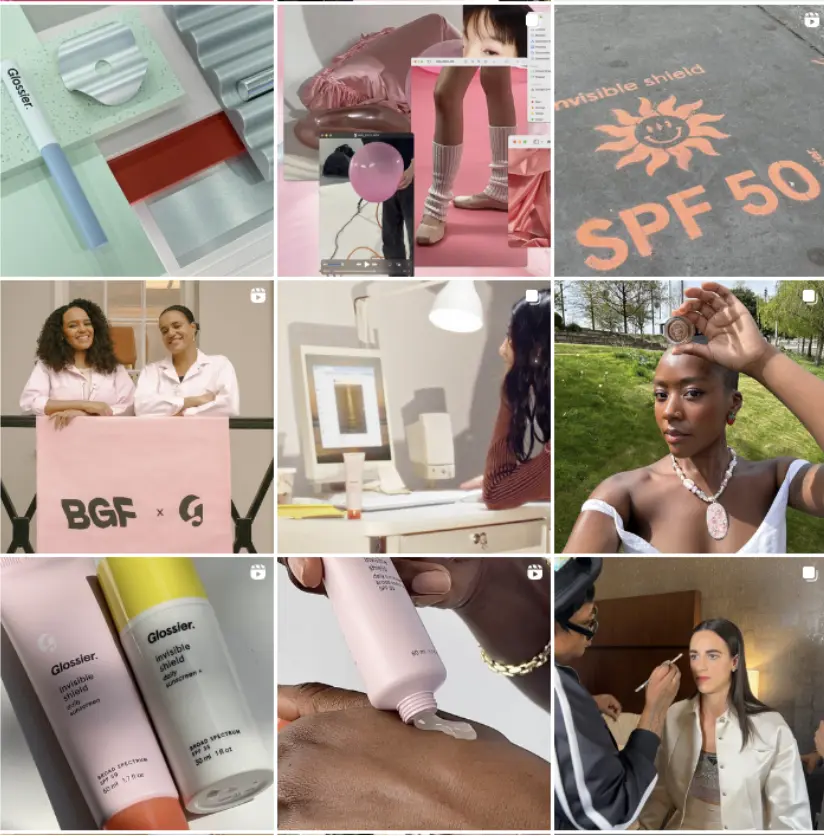
Glossier appeals to its young audience with its aesthetic social media page. Screenshot via Instagram
2. Making Products Inspired by Customers
Glossier leverages its loyal customers to mine for information on what people look for in cosmetics. They talk to existing customers, beauty enthusiasts, and influencers through messaging boards, chats, and other events.
The result? Glossier introduced products that went on to be a huge success, like the Milky Jelly Cleanser, known for its mild formulation for glowy skin.
3. Being Authentic to the Brand and the Community
Glossier believes the best brand representatives are people who look like their diverse audience. And it has tapped Instagram to find them.
The brand also collaborated with its community members, turning them into Glossier’s homegrown micro-influencers. These strategies cemented the relationship and trust the customers have with the brand.
Fenty Beauty: Unleashing the Fenty Effect
Rihanna’s brand, Fenty, is a disruption in the beauty industry. It took diversity and inclusivity to the next level by launching 40 shades of foundation for varying skin tones, sparking the beauty revolution.
1. Breaking the Mold
Before Fenty dropped its foundation line, most brands only had a dozen or so shades, which is a challenge for POCs or people of color. Setting a new standard in the industry, Fenty embraced the challenge and created shades for every color as part of its makeup branding identity.
It has proven consistent with its goal of championing inclusivity by pushing societal acceptance through its products. Soon after, cosmetic brands followed suit, dismantling the makeup racism.
This phenomenon, dubbed the Fenty effect, has put the brand at the top.
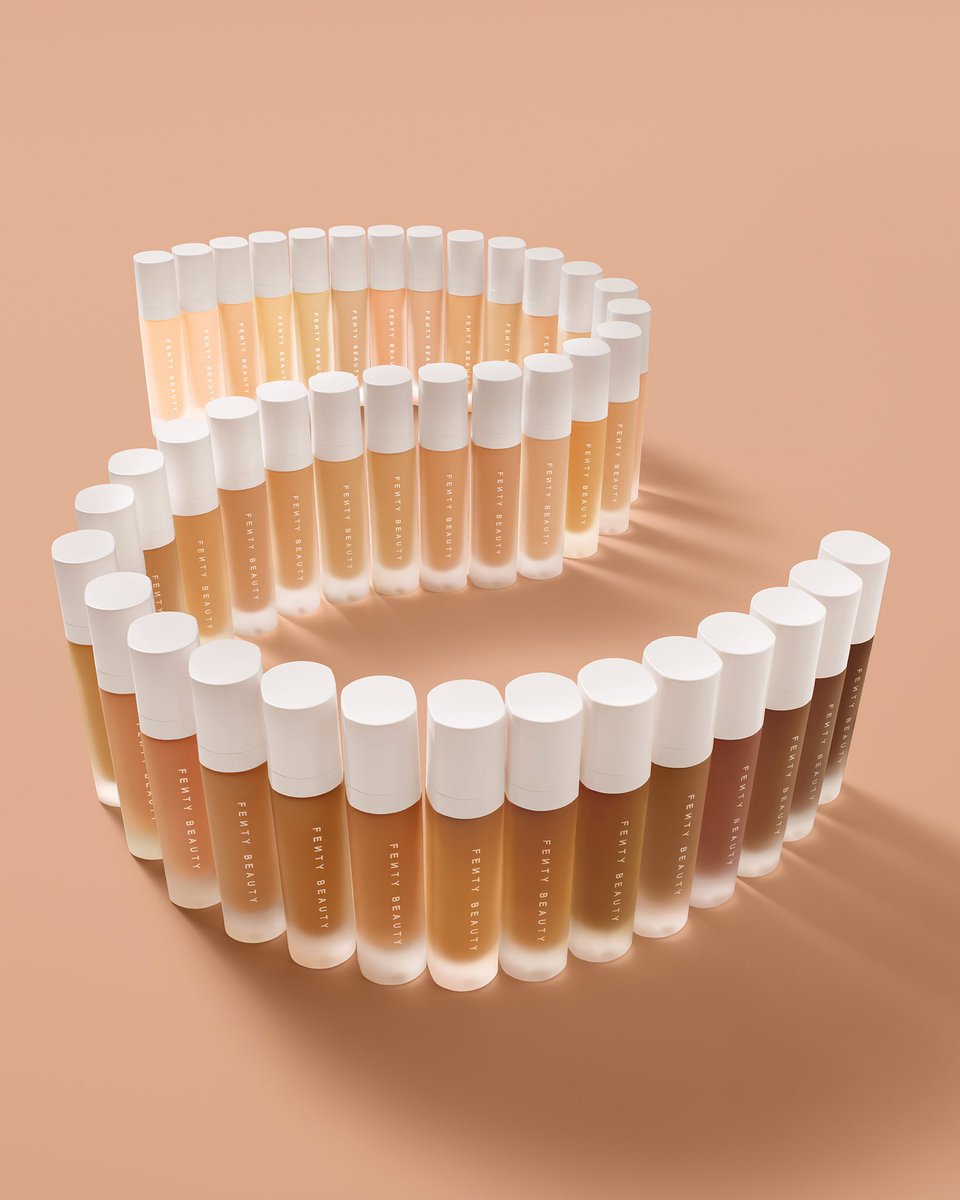
Fenty shows what diversity in beauty means with its 40 shades of foundation makeup. Image via X
2. Symbol of Passion and Empowered Women
Rihanna, a powerful symbol in and out of the entertainment industry, has been an integral part of Fenty. She uses her talent and platform to inspire a generation of badasss, which aligns with Fenty’s products and marketing campaigns.
Fenty has been vocal about social issues surrounding racism, injustices towards women, and environmental challenges, too. It supported causes like the BLM (Black Lives Matter) movement and partnered with environmental organizations like Climate.
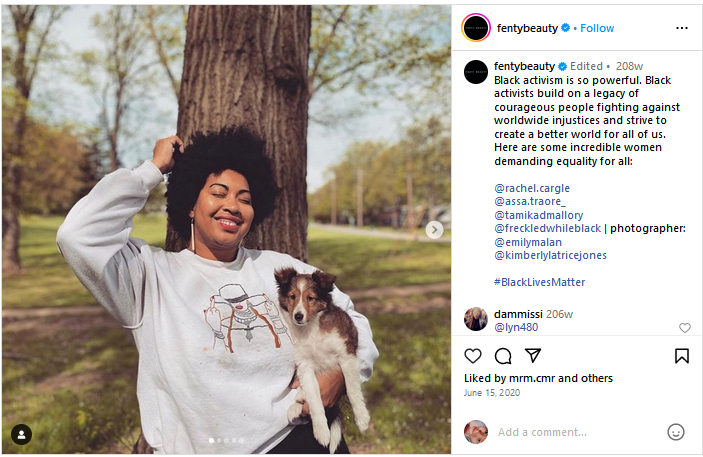
Fenty stays authentic to its values by advocating against racism. Image via Instagram
E.l.f Cosmetics
Beauty need not be expensive. And that’s exactly what e.l.f. (eyes, lips, face) Cosmetics has proven by making high-quality yet affordable cosmetic products. No wonder it won the hearts of young people.
1. Bridging the Gap Through Digital Stores
E.l.f. has gone fully digital as it delivers a convenient online shopping experience. The makeup branding move made the beauty company stand out by providing a personalized shopping experience.
With accessibility at the core of the brand, anyone can get all the information they need and reviews from real customers before making a purchase. E.l.f. also integrated AI-driven insights for a more personalized shopping experience based on previous purchases. Moreover, the brand uses AR or augmented reality so customers can try products virtually.
2. Leveraging the Power of TikTok
A core element of its branding strategy is the power of social media. One of its most notable campaigns is when E.l.f. Cosmetics was launched on TikTok Shop Super Brand Day, featuring its catchy branded song. E.l.f. then asked creators and their followers to create content using the music.
The campaign resulted in five million user-generated content and over a billion views. The song has also placed fourth in Spotify's Global Viral charts.
In a recent TikTok CGI ad, a helicopter flies a giant pimple patch to cover a zit on Mount Rushmore. The video quickly went viral, sparking intrigue, oohs, and ahs as viewers were amazed by the campaign's creativity.

E.l.f. anchors its beauty branding strategy on viral social media content. Video via TikTok
TikTok Chief Digital Officer Ektra Chopra shares, “We are where Gen Z is, and we don’t just show up, we show up bold… Before anybody was talking about TikTok, e.l.f. was there, and the reason is because our community told us about it. We are very good at looking for signals and jumping in.”
Future Trends in Beauty Branding
The beauty industry has come far. There is an emphasis on diversity and inclusivity, natural ingredients, and eco-friendly efforts. Your choice of influencers impacts how people perceive and interact with your product. And technology has pushed the boundaries in creating memorable and transformative experiences.
Moving forward, we can expect a rising demand for unisex makeup as all genders embrace cosmetics in expressing their identity. Beauty brands have to strategize for a broader market.
More beauty brands are also embracing AI in assessing and addressing the needs of customers. Some brands like Cetaphil and La Roche Posay have already launched skin analysis tools to help customers pick the right products for them.
In a nutshell, the beauty brand industry is an exciting place to be. But, it's also not for the faint of heart!
Whether you’re a startup or an established company, you can hone your cosmetic brand and gain a competitive edge. Work with a professional brand identity design company to achieve your goals.
Jun 13, 2024
